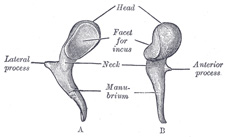
Left malleus. A. Posterior view, B. Medial view
The word [malleus] is Latin word [malleus] meaning "hammer". It is the name of an ossicle in the middle ear.
The manubrium (handle) of the malleus is attached to the tympanic membrane. The head has a ligament, the superior malleolar ligament, which suspends the malleus in place. The head of the malleus has an articular surface for the incus, which itself articulates with the stapes. Malleus, incus, and stapes are the three ossicles found in the middle ear. This chain of bones allows mechanical transmission of the movement of the tympanic membrane through to the inner ear. At the base of the malleolar manubrium there is a site for attachment of the tensor tympani muscle which tenses and relaxes the tympanic membrane.
The Latin word [malleus] is the base for the root term [-mall-], which we can see in the English words [mallet] and even [malleable], which is used in the sense of "something able to be hammered into shape".
Interesting fact: The word [mall] as in "shopping mall" arises from an old Italian game similar to croquet called [pallamaglio]. [palla] means "ball" and [maglio] (from the Latin malleus) means "hammer". The game was quite popular in England where the word evolved from [pallamaglio] into [paille-maille] and then [pall-mall]. Since the game was played in long alleys and streets, some of these began to be referred as [malls], eventually these streets began to be lined with stores, evolving the term into [Shopping Mall].
Sources:
1 "Tratado de Anatomia Humana" Testut et Latarjet 8 Ed. 1931 Salvat Editores, Spain
2. "Anatomy of the Human Body" Henry Gray 1918. Philadelphia: Lea & Febiger
Image modified by CAA, Inc, Original image courtesy of bartleby.com



